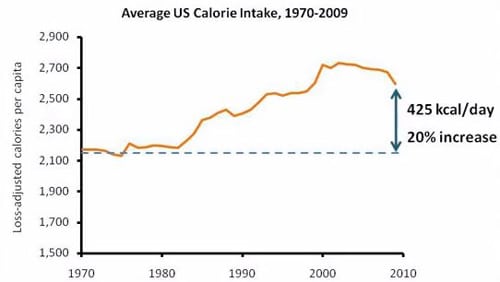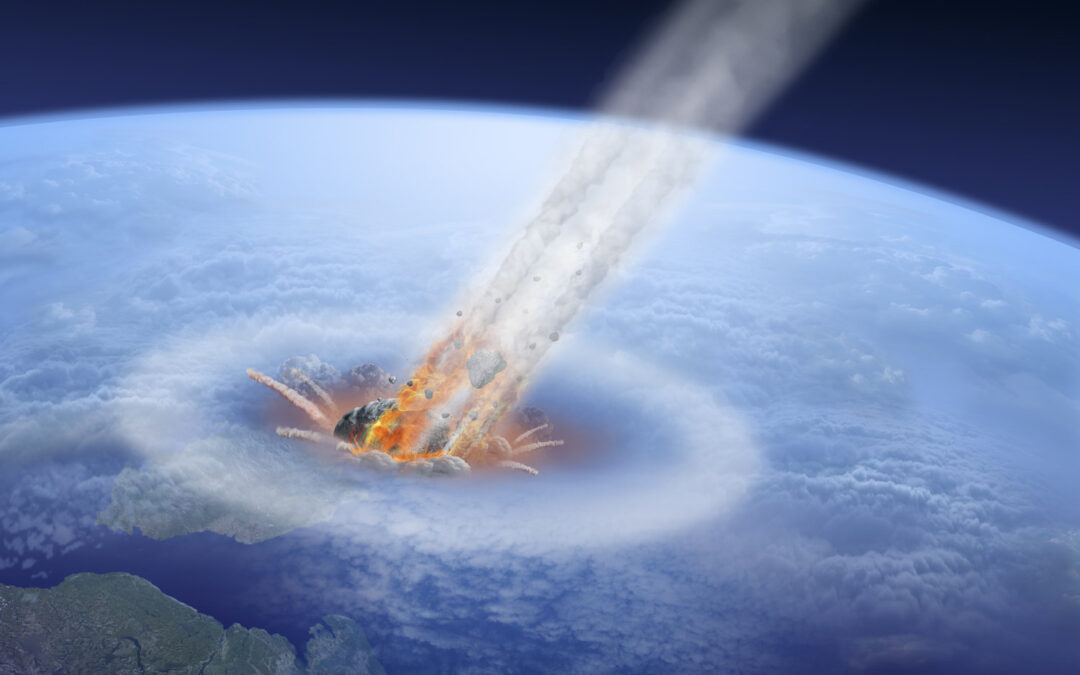Nutrition
ASTEROIDS, MONKEYS
AND OUR DIETARY JOURNEY
This article covers our dietary story, recent changes in human diet, genetics and evidence to help you avoid premature death
CATCHING A HEAVENLY BREAK
Sometimes you need a little luck. Sixty six million years ago it came in the form of an asteroid 10-14 km in diameter slamming into the present day Yucatan peninsula. It brought the 180 million year reign of the dinosaurs to an abrupt end. Until that moment reptiles were alpha. Dominating almost every aspect of animal life on earth. They were so efficient at predation that mammals could barely eek out a living as small nocturnal rodents.
With the dinosaurs gone the mammalian party cranked up. One of the first arrivals were proto-primates (Small squirrel like creatures) which soon gave rise to pro-simians (lemur like animals) dating back to 50 million years ago. As atmospheric oxygen doubled, the pro-simians gave way to larger brained monkeys 33 million years ago. The monkey business led to the first great apes 23 million years ago. The apes split up about 9 million years ago into gorillas and chimps. Soon there was a key divide between chimps and the first hominids (human-like primates) seven million years ago.

CHIMP MODE
Up to this point our ancestors were consuming a plant based diet and our close cousins the great apes today are plant based eaters. Chimpanzees, our closest living relative who share 99% of our DNA are 92-95% plant based. All other great apes such as orangutans and gorillas, which share 97% and 98% of our DNA respectively are 100% plant based except for the occasional termite snack. From a lipidology (study of blood fat and cholesterol disorders) standpoint I’m fascinated by them. It turns out that chimpanzees are homozygous (have two copies of the same types of gene (alleles)) for a highly atherogenic (plaque producing) protein called APOE4. This form of APOE predisposes individuals to heart attacks and strokes.
[Side note: 10-15% of people have at least one copy of APOE 4 which increases the risk for Alzheimer’s. One copy of APOE4 increases risk by 2 to 3 times while two copies (E4/E4) can increase the risk 12 fold. (The personal genetics company 23andMe has received FDA approval in 2017 to offer this test to the public)].
Chimps also have high levels of another protein called LP(a)- “LP little a” which is another strong cardiovascular risk marker. Chimps are also born with high LDL (“bad”) cholesterol levels and maintain them throughout life. Despite this cardiovascular trifecta of APOE4, LP(a) and high LDL, there has never been a reported myocardial infarction (heart attack) in the autopsy records of chimpanzees at major US primate centers. (This is not to be confused with myocardial fibrosis in great apes which is common).
What’s going on with these chimps? The best explanation is what they eat. Chimps in the wild and at major US primate centers are consuming a 90+ % whole food plant based diet. When captive chimps are fed the standard American or high cholesterol diet guess what? Not surprisingly they have heart attacks, strokes and die prematurely.
MEAT MODE
Interestingly the success story of the genus Homo and ultimately us- Homo Sapiens- is due to an omnivorous diet. This varied diet of plants and animal products in addition to technological progress allowed us to settle and thrive in diverse climates from the tropics to the subarctic 12,500 years ago. During the Paleolithic era 2.5 million to 10,000 years ago our diet consisted mainly of root vegetables, fruits, meats, nuts and seeds- we were the standard hunter-gatherer. In regards to meat, the earliest evidence of its consumption dates back to 2.6 million years ago.
Why did our ancestors start consuming other animals? Simple, it was a more efficient way of getting diverse nutrients. Their enlarging brains required more nourishment. Tool development and a brain capable of increased abstract thought made them better hunters. This also carried with it a reproductive advantage. Less time spent hunting, gathering and chewing freed up energy for reproduction and child rearing. This was critical because their average lifespan was likely between 20-30 years. Fast forward and the transition from foraging to agriculture began approximately 12,500 years ago. With the dawn of the Neolithic age we, were now in control of the buffet line. By raising our own crops and domesticating cattle, pigs, sheep, goats, birds, etc…we were able to form communities and connect (share new ideas and collaborate) with others. Animal product consumption became a steady part of our diet. Lifespan improved to 25–40 years of age. The dawn of modern civilization began to unfold. As time progressed, record keeping improved. Some records show the average Roman male 2000 years ago lived to age 30-45 years. In 1800 the average male in London lived to age 40. Life expectancy in the U.S. for males in 1907 was 45.6 years; by 1957 it rose to 66.4 years and by 2007 it had risen to an impressive 75.5 years. With the advent of modern sanitary practices and medicine life expectancy has soared. Infectious disease was replaced by cardiovascular disease, cancer and neuro-degenerative (Alzheimer’s, Parkinson’s, etc) disorders as the most common causes of death.
BIG FOOD-BIG PEOPLE
The 20th century not only brought with it increased lifespan but a profound change in our diet. It’s interesting to look at black and white photos – pre World War II- and notice how few people are overweight or obese. What changed? The food content and food distribution chain underwent an “Incredible Hulk” transformation after World War II. It essentially mutated into a highly efficient corporate driven juggernaut hell bent on using addictive food tactics to create repeat business. Large amounts of sugar, salt, refined carbohydrates and fats were added to the American diet. Combined with new food distribution strategies such as fast food, convenient stores, restaurants and “super” grocery stores, a big food industry net was cast over the entire nation. In evolutionary terms this happened almost as fast as the asteroid slamming into the Yucatan. Instead of dinosaurs, it’s ideal body weight that’s being pushed to the brink of extinction. Greater than 75% of American adults are overweight or obese. There are now 2.5 billion obese adults across the planet. The cost of obesity in the U.S. in 2017 was $1.7 trillion according to the Milken Institute – more than spent on national defense.


Dr. Stephan Guyenet. The American Diet.
Whole foods have given way to a highly processed, inflammatory and calorie dense on the run style of eating. A quickening world has intruded into our bonding and connection with family and friends over the dinner table. We are connected more than ever, yet feelings of isolation, depression, anxiety and suicide are at all time highs. The stress and disconnect from our natural selves has raised our cortisol levels and promoted more caloric consumption in the form of refined carbs (comfort food). Our genes are simply not equipped to handle the Standard American Diet (aka S.A.D.). Sleep deprivation and lack of exercise have exacerbated matters. Finally, egoic based conditioning has left many vulnerable to deep emotional triggering by mass media and social media. Our unbalance progress has brought us to the tipping point.

So, with the obesity epidemic and all this meat eating over the past couple of million years why do I recommend a plant based diet and not a Paleo/Keto Diet? First, unlike our ancestors, food in Western society today is no longer scarce. We have the luxury of choosing the best sources of calories and nutrients. Second, we are living longer which means chronic diseases such as heart attack, stroke, cancer and neuro-degenerative (Alzheimer’s, Parkinson’s, etc) are the major causes of deterioration and death. Consuming foods that prevent these conditions is a smart strategy.
We know most chronic diseases are linked to animal product consumption. In October of 2015 the most respected medical journal in the world- The Lancet– reported on the World Health Organization classifying processed/cooked meats into the highest category of cancer causing substances along with arsenic, smoking, asbestos and alcohol. A high animal fat diet is also known to increase risk of cancer.
There is only one diet that has ever been shown to reverse the most common killer in the United States- cardiovascular disease- and that research performed by Dr. Dean Ornish, Dr. Larry Scherwitz and others was also published in the Lancet. For those who point to the high animal protein diet of the Inuit (Eskimos) and high dairy intake of the Masai tribe as examples of humans safely consuming these food sources, autopsies on both populations have shown extensive blockages in their coronary arteries by age 40-50 comparable to older American men.
How about the brain? In 2002 a researched published in Neuroscience showed rats fed a typical Western diet high in sugar and saturated fats showed significant decline in new learning and memory. A protein known as Brain Derived Neurotrophic Factor (BDNF) which promotes new neuron development, protects existing neurons and enhances synaptic activity between neurons was profoundly reduced in rats fed a high saturated fat and sugar diet. Reduction in cognitive decline were reduced proportional to the decrease in BDNF. In humans, BDNF has clearly been shown to play an essential role in increasing brain volume and maintaining cognitive functioning.
Finally, we have 66 plus million years of evolutionary biochemical and metabolic history favoring a whole food plant based diet. Meats have been part of our diets for only 3.8% of our dietary history- most of that was non-cooked as the genus Homo did not show widespread control of fire until 125,000 – 500,000 years ago (at best 0.7 % of primate evolution). Dairy products- milk, cheeses, etc- have been around a whopping 0.015% of our dietary history. Refined sugars 0.005 %. To ignore these facts is to throw massive evolutionary metabolic momentum under the bus. It’s equivalent to betting your life on a football team losing 100 – 3 late in the fourth quarter!
TAKE ME HOME JAMES
There has simply been very little evolutionary pressure to live past the of age of 30-40 as the act of reproduction has been completed in younger years. Recent human dietary changes have occurred quickly. There’s a tremendous lag behind what we are currently eating and what our genes are optimized to do. Neglect of these simple facts is eating at one’s own peril.
As a physician with over 20+ years of health coaching I have witnessed the transformative power of a plant based diet in countless patients. Disease and age reversal is the new medicine. Not only can you add vitality and years to your life, but you can do so without feeling deprived. Finding healthy food that you enjoy is one of the cornerstone’s of my coaching.
Eating healthy, however, is not enough. I will help you identify and conquer the stress, emotions and any other factors that are blocking you. I have indeed “seen it all.” You will not have any surprises that my coaching cannot handle.
You now have a science based account of our dietary story. This story is telling you to play to your natural strengths and break free from the addictive and self destructive manipulation of the big food industry. You can turn back the clock. You can reprogram your mind’s operating system. You can heal yourself with the right process and support. You will experience quick and sustainable results that will enhance performance in all aspects of your life.
Reach out for a free “Meet the Coach/Doc” chat to see if my coaching is right for you.
To your health,
Reed Miloy MD

